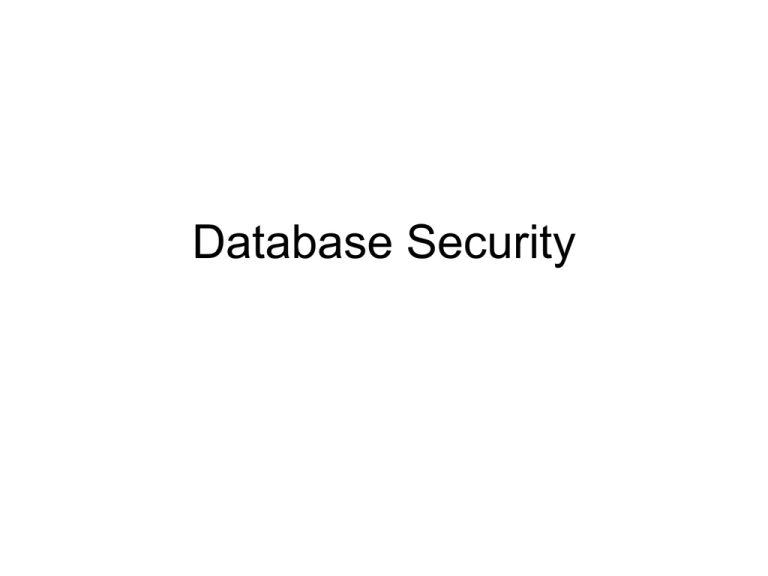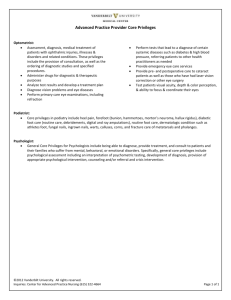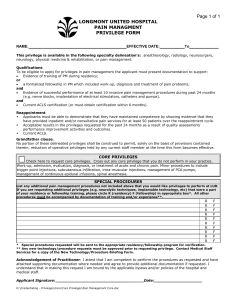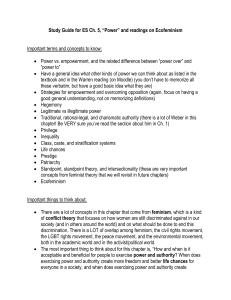Database Security
advertisement

Database Security Database Security • Multi-user database systems like Oracle include security to control how the database is accessed and used for example security Mechanisms: – Prevent unauthorized database access – Prevent unauthorized access to schema objects – Control disk usage – Audit user actions Database security Data security system security System Security covers access and use of the database at the system level, such as: • the username and password • the disk space allocated to users, • and the system operations that users can perform Data security covers access and use of the database objects and the actions that those users can have on the objects such as selecting data from a table or retrieving a value from a sequence User Security • AAA security model: – Authentication: verifying the identity of someone (a user, device, or an entity) who wants to access data, resources, or applications. • It give us initial access & many authentication methods – Authorization: Access limits for authenticated users • Least privileges principle: user must be able to access only the information and resources that are necessary for its legitimate purpose and no more – Accounting: auditing User Security • • • • DB Account Privileges Roles profiles User Accounts • Default user accounts: – The following administrative user accounts are automatically created when you install Oracle Database • SYS: granted by DBA role, owns Data Dictionary • SYSTEM: granted the DBA role. This is the user account that you log in with to perform all administrative functions, except: 1. 2. Startup and shutdown database Backup database Components of an oracle user account • Unique username : it should be less than 30 character, contains alphanumeric, $ and _ – You can not use keyword. E.g. insert, create … etc. • • Authentication method: password, OS or biometrics Default tablespace to store data – It will be set to SYSTEM if not specified • temporary tablespace for query processing work space • Profile: It allows you to regulate the amount of resources used by each database user & enforce complexity of password – To apply specific setting to a group of users. First create a profile then assign users to it. • account status : it can be: open, locked( attempts) or expired Creating Users • The DBA creates the user by executing the CREATE USER statement. • The user does not have any privileges at this point. • The DBA can then grant privileges to that user. • These privileges determine what the user can do at the database level. Creating Users • The syntax for creating a user is: CREATE USER user IDENTIFIED BY password DEFAULT TABLESPACE tablespace_name TEMPORARY TABLESPACE tablespace_name QUOTA [UNLIMITED ] [integer M] on tablespace_name PROFILE profile_name; • Example: CREATE USER Scott IDENTIFIED BY tiger DEFAULT TABLESPACE system TEMPORARY TABLESPACE temp QUOTA UNLIMITED on system PROFILE managerProfile; User created. Privileges • Privileges are the right to execute particular SQL statements. The database administrator (DBA) is a high-level user with the ability to grant users access to the database and its objects • Example: The ability to connect to the database The ability to create a user The ability to create a table • System privileges: Gaining access to the database • Object privileges: Manipulating the content of the database objects schema • A schema is a collection of objects, such as tables, views, and sequences. • The schema is owned by a database user who create it and has the same name as that user. System Privileges • System privileges can be given to a user by another user who has administrator privileges or by a user who has the right to grant a system privilege • More than 200 privileges are available such as: – Creating new users – Removing users – Removing tables – Backing up tables • Special Administrative privileges: required for an administrator to perform basic database operations are granted through two special system privileges • SYSDBA privilege: can do anything • SYSOPER privilege: sub-admin access, can perform: – Backup, recover, startup, shutdown – No access to data itself System Privilege CREATE USER Operations Authorized Grantee can create other Oracle users (a privilege required for a DBA role). DROP USER Grantee can drop another user. DROP ANY TABLE Grantee can drop a table in any schema. BACKUP ANY TABLE Grantee can back up any table in any schema with the export utility CREATE ANY TABLE Grantee can create tables in any schema. SELECT ANY TABLE Grantee can query tables, views, or snapshots in any schema User System Privileges • Once a user is created, the DBA can grant specific system privileges to a user. GRANT privilege TO user [WITH ADMIN OPTION] ; • WITH ADMIN OPTION: it means give grantee right to grant the same privileges to other users • An application developer, for example, may have the following system privileges: – CREATE SESSION – CREATE TABLE – CREATE SEQUENCE – CREATE VIEW – CREATE PROCEDURE Granting System Privileges • The DBA can grant a user specific system privileges. Example: GRANT create session, create table, create sequence, create view TO Scott; Grant succeeded. Object Privileges • • An object privilege is a privilege or right to perform a particular action on a specific (object) table, view, sequence, or procedure Each object has a particular set of grantable privileges. The table in the next slide lists the privileges for various objects Object Privileges Object Privileges • Object privileges vary from object to object. • An owner has all the privileges on the object. • An owner can give specific privileges on that owner’s object. • Syntax: GRANT object_privilege [(columns)] ON object TO user [WITH GRANT OPTION]; • If the grant includes WITH GRANT OPTION, then the grantee can further grant the object privilege to other users; otherwise, the grantee can use the privilege but cannot grant it to other users. Granting Object Privileges • Grant query privileges on the EMPLOYEES table. GRANT select ON employees TO Norah, Sarah; Grant succeeded. • Grant privileges to update specific columns to users and roles. GRANT update (department_name, location_id) ON departments TO Scott, manager; Grant succeeded. How to Revoke Object Privileges • Remove privileges granted to other users by using the REVOKE statement. When you use the REVOKE statement you prevent the user from doing specific actions depending on the privileges you revoke from the user. How to Revoke Object Privileges • Syntax: REVOKE privilege ,ALL ON object FROM user,role,PUBLIC; Example: REVOKE select, insert ON departments FROM Scott; Revoke succeeded. How to Revoke Object Privileges • Privileges granted to others through the WITH GRANT OPTION clause are also revoked. • For example, if user A grants SELECT privilege on a table to user B including the WITH GRANT OPTION clause, user B can grant to user C the SELECT privilege with the WITH GRANT OPTION clause as well, and user C can then grant to user D the SELECT privilege. If user A revokes privilege from user B, then the privileges granted to users C and D are also revoked. What Is a Role? • A role is a named group of related privileges that can be granted to the user. • This method makes it easier to revoke and maintain privileges. • user can have access to several roles, and several users can be assigned the same role • Pre-defined roles: – DBA: it has all system privileges (which SYS/SYSTEM have) – RESOURCE: Enables a user to create certain types of objects in his own schema – CONNECT: Enables a user to connect to the database. Grant this role to any user or application that needs database access. Creating and Assigning a Role • First, the DBA must create the role. Then the DBA can assign privileges to the role and users to the role. Syntax CREATE ROLE role; Creating and Granting Privileges to a Role • Create a role CREATE ROLE manager; • Grant system privileges to a role GRANT create table, create view TO manager; • Grant a role to users GRANT manager TO Maha, Nora; Changing Your Password • The DBA creates your user account and initializes your password. • You can change your password by using the ALTER USER statement. • Syntax ALTER USER user IDENTIFIED BY newpassword; EX: • ALTER USER Scott IDENTIFIED BY lion; User altered. Using the WITH GRANT OPTION and PUBLIC Keywords • Give a user authority to pass along privileges. GRANT select, insert ON departments TO Scott WITH GRANT OPTION; Grant succeeded. • Allow all users on the system to query data from Alice’s DEPARTMENTS table. GRANT select ON alice.departments TO PUBLIC; Grant succeeded. User Security Guidelines • To grant privileges on an object, the object must be in your own schema, or you must have been granted the object privileges WITH GRANT OPTION . • An object owner can grant any object privilege on the object to any other user or role of the database. • The owner of an object automatically acquires all object privileges on that object. • Do not give your users more abilities than they need to get the job done. • Expire and lock unnecessary users. • Create many user profile, each with different level of security setting then assign each one of them to appropriate group of user based on their privileges. Transparent Data Encryption • Oracle Database 10g uses authentication, authorization, and auditing mechanisms to secure data in the database, but not in the operating system files where the data is stored. • To protect those files, Oracle Database 10g provides transparent data encryption. This feature enables you to protect sensitive data in database columns stored in operating system files by encrypting it. • Transparent data encryption enables simple and easy encryption for sensitive data in columns without requiring users or applications to manage the encryption key. How Transparent Data Encryption Works • Transparent data encryption is a key-based access control system. Even if the encrypted data is retrieved, it cannot be understood until authorized decryption occurs, which is automatic for users authorized to access the table. • single key is used regardless of the number of encrypted columns for one table • Creating a New Table with an Encrypted Column CREATE TABLE employee ( first_name VARCHAR2(128), last_name VARCHAR2(128), empID NUMBER, salary NUMBER(6) ENCRYPT ); • Encrypting Unencrypted Columns ALTER TABLE employee MODIFY (first_name ENCRYPT); • Disabling Encryption on a Column ALTER TABLE employee MODIFY (first_name DECRYPT); links • http://www.dba-oracle.com/art_karam_oracle_user_security.htm







